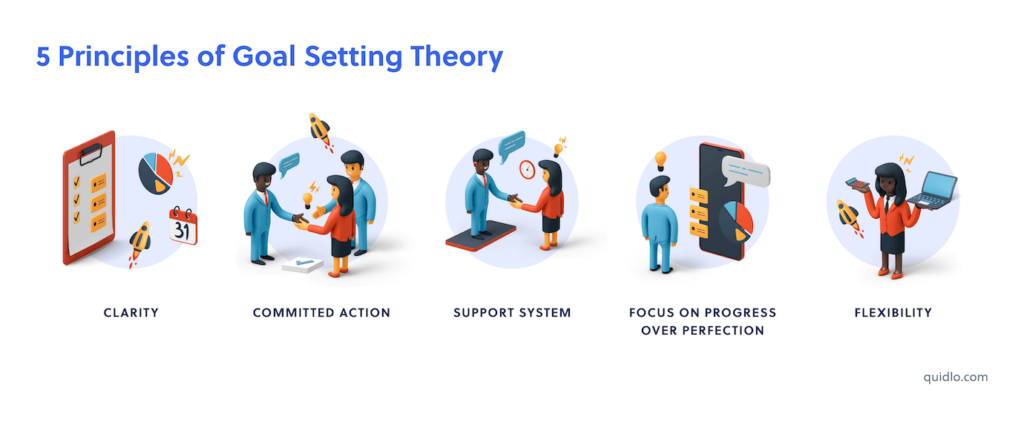Have you ever struggled with staying motivated? Have you set goals for yourself, only to abandon them shortly thereafter? If this sounds familiar, then the Goal Setting Theory of Motivation may be an important tool in helping you achieve your desired outcomes.
This theory proposes that goal setting is a key factor in determining motivation and has been used extensively across a variety of fields to help individuals focus their energy on reaching long-term objectives. In this post, we will take a closer look at how the Goal Setting Theory works and explore strategies that can improve your chances of success.
Table of Contents
What is a Goal Setting Theory Of Motivation
Goal Setting Theory (GST) is a motivational theory developed by Edwin A. Locke in the early 1980s. This influential approach to motivation has been widely studied and applied, both in academic circles and in the corporate world.
Locke’s Goal Setting Theory is based on the idea that individuals strive to reach specific goals they have set for themselves, and this striving leads to increased task motivation, engagement, and commitment
History of Goal Setting Theory
The roots of GST can be traced back to the early 1950s, when Dr. Edwin Locke was studying the work of prominent psychologists such as Abraham Maslow and Harry Harlow.
However, it wasn’t until 1966, when Locke published his first paper on goal setting, that he truly began to develop his theory. In this paper, Locke argued that goals provide direction, motivate action, and increase task performance significantly more than simple instructions or verbal guidance alone
In 1968, Locke conducted further research with Gary Latham, which resulted in their famous “Pygmalion Effect” paper. This study demonstrated how setting clear goals can lead to increased performance – a result that was later dubbed the “self-fulfilling prophecy.”

The findings from this research provided further evidence for the efficacy of goal setting as an effective tool for motivating employees. As a result of this goal-setting research, Locke continued to refine his theory throughout the 70s and 80s – leading us to where we are today with Goal Setting Theory.
👉 Read more about The Pygmalion Effect on our blog.
Central Tenets of GST
The core beliefs of GST are fairly straightforward:
Goals should be specific enough so that progress can be measured.
They should also be difficult yet attainable.
Feedback should be provided regularly.
Task complexity should increase over time as people make progress toward their challenging goals.
Rewards should accompany goals if they are met – either extrinsic (e.g., money) or intrinsic (e.g., satisfaction).
GST emphasizes that failure is not only acceptable but necessary for learning. It’s through our mistakes that we grow and become better people over time
5 Principles Of Goal Setting Theory

The Principles of Goal Setting Theory (GST) are a set of guidelines that help individuals plan, achieve, and maintain challenging yet attainable objectives in their lives. GST has been widely accepted and studied by academics, researchers, and practitioners alike as one of the most effective frameworks for personally challenging goal setting. Below are the key principles of the theory and how they can be used to achieve measurable goals.
1. Clarity
The first principle of GST is clarity. Individuals must be able to clearly define their performance goals in order to focus their energy on achieving them. According to this theory, clarity around goal orientation is a must. The clearer you are about what you want to accomplish, the easier it is to create action plans that will help you get there.
When creating goals, it’s important for individuals to avoid being overly vague or too ambitious with their targets. They shouldn’t set difficult goals. Specificity is essential when creating achievable goals that can be tracked and measured over time.
2. Committed Action
Once individuals have defined their goals in clear terms, they must commit to taking action toward achieving them. Taking goal commitment means committing yourself both mentally and physically toward reaching your goal.
This could involve setting aside regular blocks of time where you focus exclusively on working towards your target or researching helpful resources that will allow you to make progress faster. Individuals who take consistent action tend to reach their specific and challenging goals more quickly than those who don’t take any action at all or engage in sporadic bursts of activity followed by long periods of inaction
3. Support System
Having a support system is an important part of staying motivated when working towards a goal over an extended period of time. A strong support system includes family members, friends, mentors, or colleagues who understand your vision and provide continual encouragement along the way.
Additionally, it may be beneficial for individuals to join support groups related to their particular field or area of interest as this can provide access to additional resources, including advice from more experienced professionals within the same field.
4 . Focus on Progress Over Perfection
Another key element of GST is focusing on progress over perfection. While some degree of perfectionism can be beneficial, it is important not to let perfectionistic tendencies impede progress toward one’s objectives.
Focusing on progress instead means breaking down large tasks into smaller achievable milestones so that each step can be celebrated as an accomplishment rather than seeking out errors or inconsistencies in results achieved thus far. By focusing on small wins along the way, individuals are able to stay motivated while moving closer to accomplishing their overall objective.
5 . Flexibility
Flexibility is essential when striving towards a goal since obstacles often arise along the way, which require creativity and problem-solving skills in order for success to be still achieved. Additionally, circumstances may change over time which necessitates adjusting strategies accordingly so as not to become stuck in outdated methods that no longer apply given current conditions.
Being open-minded with regard to approach allows for innovation and adaptation, which enables greater success rates with respect to reaching self-defined goals even when faced with unexpected challenges along the path forward.
Advantages of Goal Setting Theory of Motivation
1. Increased Motivation:
Setting goals gives individuals a clear sense of purpose and motivation to succeed and accomplish them. Goals can provide direction, focus, and clarity in order to help individuals progress.
When working towards a goal, it can be easier to stay on track and motivated than if there is no goal in sight. Goals often serve as a source of inspiration, providing the necessary drive for someone to work hard on a complex task and strive for success.
2. Improved Performance:
The ability to effectively set achievable goals can have a positive effect on human performance levels. When goals are set that are realistic and achievable, it motivates an individual to remain focused and determined to reach them.
Having an attainable goal provides both short-term motivation as well as long-term achievement satisfaction. This assists with higher performance in the workplace or any other environment where the goal is being pursued.
3. Self-Awareness:
Establishing goals allows an individual to become aware of their strengths and weaknesses – enabling them to identify areas that need improvement or further development in order to achieve their desired outcome more effectively.
By setting achievable goals, it encourages self-assessment, which allows one to monitor their progress over time whilst adjusting areas that may be hindering success along the way
4. Sense Of Accomplishment:
Achieving a goal brings about a sense of pride, joy, and accomplishment that cannot be replaced by anything else. This encourages future success by reinforcing positive organizational behavior each time a goal is attained successfully.
In addition, when someone sets out to reach their desired outcome, it promotes self-confidence, which leads them down the path of consistently achieving new heights without fear of failure or disappointment from not attaining what is intended at the first attempt
5. Improved Time Management Skills:
Goal setting requires efficient time management skills in order for tasks within the timeline allocated for achieving the specific objectives to be completed efficiently without falling behind schedule or missing any deadlines altogether.
This teaches individuals how best to utilize all available resources within given timescales in order to get things done efficiently yet productively with great results each time around
6. Increased Productivity Levels:
Working towards predetermined objectives helps individuals stay organized as they are able to focus on what needs doing next at every stage until all tasks leading up to obtaining the desired result have been fulfilled accordingly.
This encourages productivity levels through meaningful work rather than aimless efforts, which can prove unproductive over time, thus leading the one-off course from the intended achievement expected eventually at set intervals along the journey.
7. Strategic Thinking & Planning:
Establishing objectives forces an individual into thinking strategically about how best they will go about accomplishing these ambitions – through careful assessment of the current situation, understanding risks associated with such endeavors (if any), and making plans accordingly that reflect reality and/or ambition behind why these targets were set initially.
All of these contribute greatly towards successful outcomes, each step taken along on route towards ultimate achievement sought after eventually upon completion.
Limitations of Goal Setting Theory
1. Unrealistic Expectations:
One limitation of Goal Setting Theory is that employees may set unrealistic expectations for themselves and mistake short-term goals for long-term ones. This can lead to a lack of motivation as they are unable to meet the expectations they have set and feel overwhelmed with the challenge in front of them
2. Limited Focus:
Goal-setting theory can limit an employee’s focus on their own personal goals, potentially ignoring team or organizational objectives. As goals become increasingly complex and involve multiple departments, this can create a bottleneck on progress and limit the scope of what can be achieved within a given timeframe
3. Unclear Rules:
When it comes to goal setting, employees must be given clear guidelines in order to complete their tasks effectively and efficiently. If rules are not provided or not understood, there is a greater chance for mistakes or oversights, which could cause delays in project timelines or even lead to failure altogether
4. Lack of Resources:
Even when expectations are realistic, if employees do not have access to sufficient resources required to meet those goals, then they will be unable to achieve them in the desired time frame. This could lead to dissatisfaction among workers as well as missed opportunities due to a lack of resources.
5. Unclear Goals:
If goals are not clearly defined and communicated, then employees may struggle when attempting to reach them due to confusion over what exactly is expected from them or how best it should be achieved.
Goal Setting Theory Examples
Goal setting theory is a practically useful theory that can be used to accomplish both short-term and long-term objectives. Setting goals allows individuals to measure progress, channel energy in the right direction, and stay motivated even when faced with setbacks.
Whether you’re trying to become more organized or are working towards greater success professionally, goal setting theory provides an excellent framework for helping to reach ambitious targets.
Let’s take a closer look at some specific examples of how it can be applied in various settings.
Goal Setting Theory in Business
Goal setting theory is often used by businesses to ensure that all employees are working towards common goals, improving motivation and productivity levels. When applying GST within an organization, managers typically do the following:
• Establish company-wide goals: Companies should clearly communicate what they want to achieve through goal setting, so employees understand expectations and have something to work towards
• Break down these goals into smaller objectives: It’s important for companies to break down larger goals into smaller tasks or milestones so staff can measure progress along the way
• Give employees autonomy: Employees need autonomy in order to feel empowered and motivated in their roles. Allowing them a choice when it comes to task selection or methods of completing tasks can help increase job satisfaction and performance levels
• Provide feedback regularly: Managers should provide regular feedback on employee performance against set objectives, giving praise for successes or constructive criticism for areas that require improvement
An Example Of How Goal Setting Theory Works In Business
Let’s take a look at an example of how GST works within a business environment. Let’s say a company wants to increase its profits by 10% over the next 12 months. This would be the company’s overarching goal which needs to be communicated clearly to all department heads, managers, and employees.
Everyone needs to understand what they are trying to achieve in order for them to all work together towards this goal. The individual departments then need to create their own smaller objectives that feed into this overall goal.
Each team may decide on specific targets they wish to hit throughout the coming year, such as sales targets or cost-saving initiatives, etc., while still ensuring these align with what the company is ultimately trying to achieve.
As each employee completes tasks related directly or indirectly towards achieving these objectives, he/she should receive feedback from their manager as part of the process. This could include verbal encouragement when tasks have been completed successfully or suggestions on how things could be improved if necessary.
With regular feedback like this being provided throughout the year, both parties will have a better understanding of where progress stands at any given time and whether anything needs adjusting in order for success not only at the team level but also at a company-wide level too
When applied correctly, goal setting theory can bring numerous benefits for both employers and employees alike, including increased motivation levels, improved job satisfaction and higher morale amongst staff members due to increased clarity around expectations which helps build trust amongst colleagues and management teams alike.
Goal Setting Theory in Education
Goal setting theory (GST) is a popular approach used in the education system to help students progress and achieve success. It can be used to help students develop personal learning plans that involve setting specific short-term and long-term academic goals.
By having clearly defined objectives with achievable timelines for the completion of each task or milestone, students can stay focused on reaching their desired outcomes as well as staying motivated during difficult times.
Additionally, providing rewards or incentives for completing tasks can also be helpful in motivating students to keep working hard towards attaining their ambitions
Example: Applying GST With A High School Student
For example, let’s consider a student who wants to go to college after graduating from high school but needs help developing a plan of action to get there
Objectives/Goals: The first step would be for the student to set clear educational objectives such as getting good grades throughout high school (GPA of 3.5 or higher) so they can gain entry into a top college; applying early decision if applicable; scoring well on standardized tests such as SAT or ACT; joining extracurricular activities such as debate or theater clubs; participating in internships; volunteering in the community; etc
Monitoring Progress: Next, it’s important for the student to break down each goal into smaller tasks which can then be tracked daily or weekly as part of an overall progress report which allows them to measure how far along they are towards accomplishing each objective (for example: submit 3 college applications every week)
Feedback: The student should also seek feedback from trusted teachers or mentors who can provide advice on how best to proceed towards achieving their goals (for example: taking advanced classes at school, which may lead directly into more competitive colleges)
Belief & Confidence: Lastly, it’s important for the student to maintain the belief that success is possible through hard work and dedication – even during tough times – so they don’t become discouraged while trying to reach their objectives (for example: attending study groups with other aspiring applicants).
Incentives/Rewards: Finally, once all steps have been taken towards creating an actionable plan of attack – providing incentives or rewards along the way will help motivate the student even further (for example: if grades remain consistent throughout high school, reward with gift cards or special privileges).
Bottom Line
As you can see from these examples, the Goal Setting Theory of Motivation is really quite simple and straightforward. However, it’s also very powerful in terms of increasing productivity and motivation within a business.
So if you’re looking for ways to increase motivation and productivity levels within your team, why not give the Goal Setting Theory of Motivation a try? You might be surprised at just how effective it can be! Thanks for reading, and we hope this helped.







